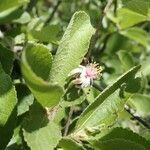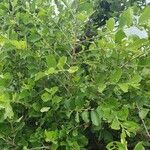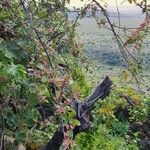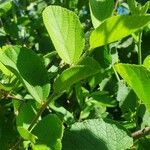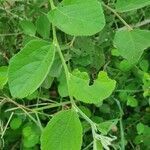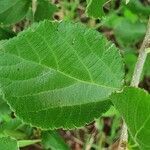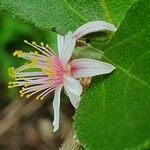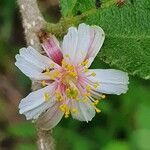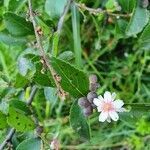Shrub to 4.5 m tall; young stems pubescent, older branches greyish brown.. Leaves obovate, up to 5.5 cm long, 4.2 cm wide, acute to rounded at the apex, cuneate to rounded at the base, margin serrate to dentate, sparsely to densely stellate-pubescent, rarely glabrescent, beneath, less dense to glabrous above; petiole up to 5 mm long, sparsely to densely pubescent; stipules 3–4 mm long.. Inflorescence a solitary flower, sometimes flowering before the leaves appear and then often in fascicles; peduncle and pedicel together appearing like a jointed pedicel, subsessile or to 14 mm long, stellate-pubescent, often with persistent bracts; bracts 3, triangular, 2–3 mm long.. Flowers white to pink, fading yellowish; sepals 7–11 mm long, white inside, reddish to white outside; petals oblong to slightly obovate-oblong, 4–8 mm long, 1.5–2.5 mm wide, rounded to truncate at the apex, sometimes notched, white, sometimes tinged with pink or lilac.. Androgynophore glabrous for ± 1 mm at the base, pubescent and produced for ± 0.5 mm above the node.. Stamens 3–6 mm long; filaments usually pink to crimson, occasionally white; anthers yellow to orange.. Ovary 1–1.5 mm long, densely hairy; style 4.5–6 mm long, white; stigma green.. Fruit (1–)4-lobed, 8–12 mm wide, the lobes 4–7 mm long, 3–6 mm wide, orange, sparsely hairy to glabrescent.. Fig. 5.
More
A shrub. It grows 4 m tall. It keeps growing from year to year. It flowers when it has no leaves. The leaves are green and can be slightly hairy on both surfaces. The leaves are 2-7 cm long by 2-5 cm wide. They are rounded at both ends. There are irregular rounded teeth along the edge. The flowers occur singly opposite the leaves. They are white to pale lilac. The fruit have 2-4 lobes. They are green when young and turn orange when ripe.
